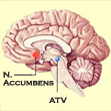Monday, 25 February 2013
Links on Pleasure-Seeking Behaviour
 This week, as I have before in this blog, I am posting a set of new links to other web sites that discuss a subject covered in The Brain from Top to Bottom. The subject this week is the sub-topic “Pleasure-Seeking Behaviour”, under the topic “Pleasure and Pain”. For each link, I also provide a brief description of the content on the site in question.
This week, as I have before in this blog, I am posting a set of new links to other web sites that discuss a subject covered in The Brain from Top to Bottom. The subject this week is the sub-topic “Pleasure-Seeking Behaviour”, under the topic “Pleasure and Pain”. For each link, I also provide a brief description of the content on the site in question.
Molecular Level
To be a dopaminergic neuron, a neuron must be capable of manufacturing dopamine. This article explores the workings of the genes that enable a neuron to produce this neurotransmitter.
![]() Psychosis and Salience dysregulation
Psychosis and Salience dysregulation
This blog entry explains the possible link between the dopaminergic system which assigns a value (“salience”) to some stimuli, thus making them desirable incentives, and the phenomenon of psychosis which may result from hyperactivity of this system, leading to the conscious perception of processes that are normally unconscious.
![]() A dopamine receptor gene and emotional control
A dopamine receptor gene and emotional control
The degree of control that people exercise over their emotions may be associated with variations in the dopamine D2 receptor in parts of the brain such as the amygdala or the prefrontal cortex.
![]() Researchers find a “liberal gene”
Researchers find a “liberal gene”
There may be some connections between a variant of the gene for the dopamine D4 receptor and personality traits associated with political liberalism.
Cellular Level
![]() Interactive effects of alcohol and nicotine on dopamine release in the rat brain
Interactive effects of alcohol and nicotine on dopamine release in the rat brain
A diagram illustrating the synergistic effects of alcohol and nicotine on the release of dopamine in the nucleus accumbens.
![]() Mesolimbic dopamine system circuitry
Mesolimbic dopamine system circuitry
A simplified diagram of the mesolimbic dopaminergic pathway in the rat brain, highlighting the major inputs to the nucleus accumbens and the ventral tegmental area.
![]() Biological substrates of reward and aversion: a nucleus accumbens activity hypothesis
Biological substrates of reward and aversion: a nucleus accumbens activity hypothesis
A review of experimental findings supporting the hypothesis that the processes not only of reward but also of aversion are encoded in the neural activity of the nucleus accumbens.
Psychological Level
![]() Musing on the topic of well-being or happiness…
Musing on the topic of well-being or happiness…
What we call well-being or happiness may involve a certain type of mental activity that calls on executive functions of the frontal lobe: the ability to focus on certain types of thoughts and not others, and on feelings of coherence rather than “random input from the environment and the old Pandora’s box of your past”.
Pleasure and Pain | Comments Closed







